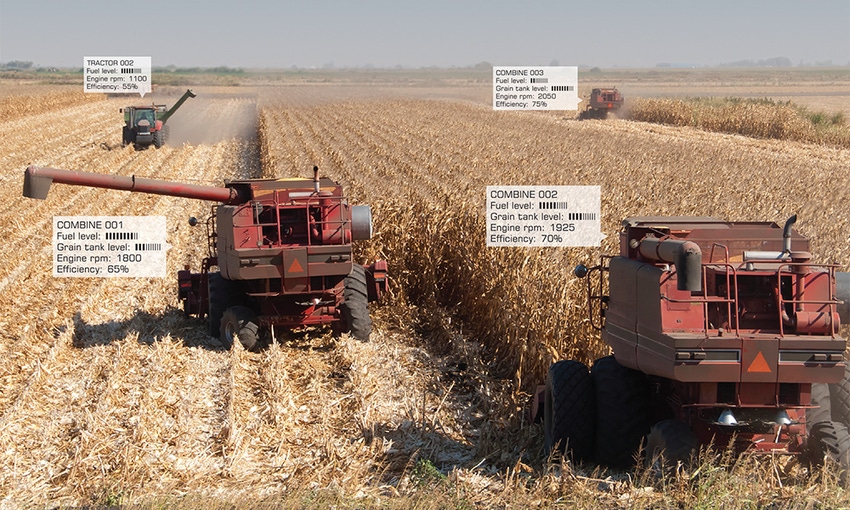October 5, 2016

For Clint Jones, managing equipment and employees is one huge balancing act. As farm manager at the University of Arizona Maricopa Agricultural Center, he’s constantly analyzing where to place employees and machinery on the 2,100-acre research farm.
A 2,100-acre farm may not sound like a huge operation, but consider Jones is overseeing research projects on fields as large as 80 acres down to one-tenth of an acre. “Often, we will have six pieces of equipment spread out across the farm, and that would make it very difficult to see what is happening at all six places,” Jones says.
He’s been operating a fleet management software program for a little over a year, and he’s already seeing significant benefits to the farm’s operation, especially when it comes to time management and gathering specific data on a machine’s operation – which is critical in a research environment.
“We can now monitor in real time where our equipment is running on the farm and we can ensure the equipment and operator is in the correct field,” Jones says. “We can also monitor operating speed of the equipment, which is another reassurance that the operator is following instructions for that particular task in that plot or field.”
Another key area is in the servicing of equipment. “We have the system set up to email us when each piece of equipment is due for service,” Jones says. “That helps to ensure that our equipment is serviced in a timely manner.”
Systems approach
It goes by many names: fleet management, fleet analytics, telematics, or the myriad of name offerings from equipment companies as well as independent services. Fleet management is nothing new to farming: matching machine and the job at hand, ferrying the right equipment to the right field during harvest, scheduling service at the right intervals...most producers have had a little black book tucked away somewhere with all those records so equipment makes it to where it’s supposed to be.
Today, these systems are more powerful than ever, and can offer producers a wealth of information at their fingertips, in real time. What producers do with this information can vary from operation to operation, but at its heart is a system that ties in the latest in computer technology with farming equipment to manage manpower and machinery.
“Fleet management programs today provide instant access to machinery, including location and operating statistics so operators can do a better job of managing equipment and employees,” says Leo Bose, manager of AFS Marketing for Case IH. “It’s real-time data that can impact the bottom line.”
For the operator with four or five combines running over several fields many miles apart, one farm manager can see, in real time, how each machine is operating, get machine parameter information, and find out how the operator is running the equipment, Bose says.
And a common misconception is that these programs are only for “big” operators. In fact, the services can show significant benefits for small to medium-sized operators, too. “For these operators, time is of the essence. Reporting flow rate, moisture, fuel usage is instant, so a producer can better manage those inputs, lowering the cost per acre by better managing the assets available.”
At its most basic level, fleet management programs are in essence data collection systems. Depending on the equipment and the telematics available on the machinery, data is constantly collected. This data is then fed into a system that analyzes the information and provides the producer specific information requested.
For service, fleet analysis allows the producer to remain close to his dealer. “We look at these services as a way that we can better support our customers and keep them up and running,” says Jeremy Goebel, aftermarket product and stakeholder manager for John Deere. “We can also use the data to help our customers optimize their equipment to get the most out of it.”
Putting data to work
With advanced diagnostics, service advisories and remote connections, connectivity helps the producer make better decisions, and allows the dealer to remotely access machinery for immediate assistance. And what this data also does is help to develop proactive services to prevent downtime. “In our line of work (customer support), we plan for events that no one wants to happen,” Goebel says. “But as we gather more information, we can use that data to be more predictive.”
While uptime and service is critical, that’s only a small part of what today’s systems can offer. But with interactive, immediate data available, producers can leverage these tools any way they want.
The key elements of a fleet management system vary. Implementing these systems depends on exactly what information you want. “The first question that has to be answered is what is your goal of using a fleet management system,” says Brandon Olstad, platform manager for Efficient Agriculture Systems at Claas. “For instance, if a harvester is not processing crop, it’s not making money. So a fleet management program can analyze machine data to work toward a consistent harvest output.”
The major component measured is efficiency. “Trimble’s Fleet Manager Service factors how the tractor is operating, when it is idle and for how long, and compares these parameters across the entire fleet,” says Gwen Byard, product manager for Trimble. “And depending on what you are measuring, you can take corrective action.”
Imagine two combines working in the same field. By analyzing the data from each machine, immediate comparisons can be made to determine if each machine is working as efficiently as possible, or if one machine may need some adjustments. “This can be a call to ask the operator to adjust speed, or mentoring the operator and training them on what they need to monitor while in the cab,” Byard says.
Instant view, quick savings
It comes down to a different, and instant, view of just how your farm is operating.
“Finding habits of equipment operators, looking for efficiencies, monitoring idle time, these are all areas where producers can often do better,” explains Ken Wagenbach, North America senior marketing specialist for AGCO. “What fleet analysis does is take the emotion out of the decision making process. Producers see clear data that can drive productivity.”
For the operator with 10 pieces of machinery in the field at one time, a gallon of fuel saved due to slight adjustments in the daily operational routine can mean huge benefits to the bottom line. “It’s tricky to define absolute producer values because it varies among producers,” Wagenbach says. “But the value is there. And in a time of low commodity prices, data is helping to ensure you are operating as efficiently as possible. That is the true meaning of fleet management.”
And fleet management factors into every aspect of the operation. Managing that data across the entire line of equipment, and jobs…whether it be planting, plowing or harvesting … is another powerful tool that fleet management offers.
“Our fleet management offerings were born out of our variable rate system introduced 10 years ago,” says Ron Osborne, vice president of business development for Farmers Edge. “So much of today’s operations and decision making is intertwined, so we developed an integrated system that works on nearly all makes and models of the farmer’s equipment, as well as an interface that monitors each piece of equipment. Using this system, we can use a common portal that pushes prescription farming, equipment alerts or fleet tracking, to all brands of equipment.”
Leveraging the entire amount of data gathered by a producer in the course of a year, a producer can integrate this information across the entire operation, allowing for enhanced information to make better and more efficient farming decisions.
The key wildcard is value, either in time efficiency or actual bottom-line dollar savings. Because it can be a nebulous term depending on the producer, the savings of a fleet management system may not be immediately visible, while the bottom line cost of the system is readily apparent. Just having the fleet management tools will not do the work for you. “Fleet management is new, it’s a monetary investment, and it takes time to become familiar with the system,” Olstad says. “There is an adoption cycle to this technology, so our job is to show producers how the system can work in their operation.”
According to data from Claas, producers can often see efficiency increases of 5% when implementing a fleet management system by reviewing data over a few days and making slight adjustments. That’s a time savings, labor savings and input savings that’s real, and goes to the bottom line. There’s also a convenience factor that is hard to assign a monetary value to,” Olstad says. “Fewer conversations on the radio, fewer calls on the cell phone, and fewer unknowns enable the fleet to better focus on the task at hand.”
“Machinery operation is a high-value part of the business,” explains Luke Zerby, Precision Land Management marketing manager with New Holland. “Fleet management gives instant information on how to best use these resources. The biggest expense may be lost time, because time is something that you simply can’t get back.”
About the Author(s)
You May Also Like






